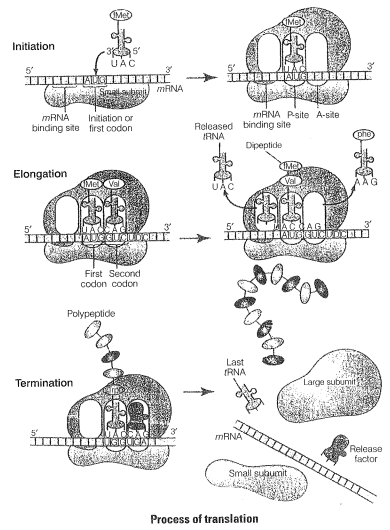Q. 4. Discuss the process of translation in detail.
There are three-stages of protein synthesis
(i) Initiation
Assembly of Ribosomes on mRNA in prokaryotes, initiation requires the large and small ribosome subunits, the mRNA, initiation tRNA and three initiation factors (IFs).
Activation of Amino Acid Amino acids become activated by binding with aminoacyl tRNA synthetase enzyme in the presence of ATP.
Transfer of Amino Acid to tRNA The AA-AMP-enzyme complex forme reacts with specific tRNA to form aminoacyl-tRNA complex.
The cap region of mRNA binds to the smaller subunit of the ribosome.
The ribosome has two sites, A-site and P-site.
The smaller subunit first binds the initiator tRNA then and then binds to the larger subunit so, that initiation codon (AUG) lies on the P-site.
The initiation tRNA, i.e., methionyl t RNA then binds to the P-site.
(i) Elongation
Another charged aminoacyl tRNA complex binds to the A-site of the ribosome. Peptide bond formation and movement along the mRNA called translocation. A peptide bond is formed between carboxyl group of amino acid at P-site and amino group of amino acid at A-site by the enzyme peptidyl transferase. The ribosome slides over mRNA from codon in the direction.
According to the sequence of a codon, amino acids are attached to one another by peptide bonds and a polypeptide chain is formed.
(ii) Termination
When the A-site of ribosome reaches a termination codon which does not code for any amino acid, no charged tRNA binds to the A-site.
Dissociation of the polypeptide from ribosome takes place which is catalysed by a 'release factor'.
There are three termination codons, i.e., UGA, UAG and UAA.


© 2025 GoodEd Technologies Pvt. Ltd.